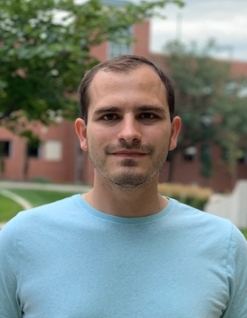The Carabeo laboratory conducts research on the interaction of the human pathogen Chlamydia trachomatis with the mucosal epithelium. Three major research questions we are addressing are:
How does Chlamydia invade non-phagocytic epithelial cells?
Chlamydiae are obligate intracellular bacteria. They require an intracellular niche for growth and replication. Therefore, access to this niche is paramount to their survival and absolutely required to initiate disease. Epithelial cells do not take up particles efficiently, and thus must be stimulated to remodel the cortical cytoskeleton to phagocytose particles, like Chlamydia elementary bodies. The molecular mechanism of Chlamydia invasion has been a long-standing interest in my lab, and we have made significant contributions in obtaining a mechanistic view of this process at the molecular level, including the identification of TarP, and elucidation of its function as a signaling scaffold to which multiple signal transduction pathway emanate, activating the actin cytoskeleton remodeling machinery. In addition to identifying the signaling complexes involved, we are also determining how these complexes are spatially organized in the context of the overall invasion landscape.
How does infection lead to scarring-related infertility?
A hallmark of advanced Chlamydia infection is fibrosis or scarring, and reproductive complications are often associated with uncontrolled fibrosis. The process of fibrosis involves three major cell types, the immune cells, the epithelial cells, and stromal fibroblasts. Stromal fibroblasts mediate the formation of scars, but they need to be activated to express specific proteins, including collagen, which is the structural component of scars. The prevailing view of fibrosis associated with Chlamydia infection is centered on the robust inflammatory response that cause indiscriminate damage to the epithelium, and repeated damage skews the response of fibroblasts from tissue repair and regeneration to fibrosis. We are investigating how infection alters the communication between epithelial cells and neighboring fibroblasts during the early stages of infection that might predispose fibroblasts to fibrosis-related activation. We are using a variety of experimental approahcs, such as 3D cell cultures, single-cell transcriptomics, and proteomic analysis.
How does Chlamydia respond and adapt to nutritional stress?
Nutritional immunity is the process of nutrient limitation as part of the host immune response to infection. This typically leads to pathogen starvation to limit its growth and replication. One of the targets of nutritional immunity is iron. Chlamydia is exquisitely sensitive to iron limitation, and thus must possess mechanisms to handle short-term iron limitation in vivo. We have identified a transcriptional regulator in Chlamydia that functions in an iron-dependent manner, i.e. its repressor function depends on sufficient level of iron. Interestingly, this synthesis of the repressor is also sensitive to the size of tryptophan pool. We also determined that the repressor regulates the trp operon, and thus the tryptophan-synthesizing capability of the bacteria. In short, C. trachomatis appears to regulate trp operon expression via a transcriptional regulatory feedback mechanism. We are investigating the biological significance of this regulation, which appears to be unique to the human pathogen C. trachomatis. We use a systems biology approach to determine genome-wide alterations to changes in transcription (single-cell and batch RNA sequencing), ribosomal profiling, and chromatin immunoprecipitation and sequencing (ChIP-seq) to determine the biological significance of the trp operon being dually regulated by tryptophan and iron levels.
Presentations |
Lab Publications |
|
|
 |
Lab Personnel
 |
Dr. Rey Carabeo – Professor |
|
|
|
 |
Dr. Amanda Brinkworth – Assistant Professor Research project – Immune evasion strategies of Chlamydia trachomatis with a focus on attenuation of cytokine signaling in infected epithelial cells |
|
|
|
 |
Monisha Alla – PhD Student MS, Vellore Institute of Technology, India Research project – Pathogen recognition of iron-starved Chlamydia trachomatis. |
|
|
|
 |
Matthew Romero – PhD student Research project – Establishment of a mechanosensitive landscape during invasion of epithelial cells by Chlamydia trachomatis |
|
|
|
 |
Amanda Stastny – PhD student Research project – Functional regulation of the chlamydial iron-dependent transcriptional repressor YtgR by site-specific proteolytic cleavage |
|
|
|
 |
Francis Fontanilla – PhD student Research project – Bystander effects of Chlamydia infection on neighboring epithelial cells and their role in modulating dissemination dynamics |
|
|
|
 |
Tyler Zimmerman - MS student Research project - Mathematical modeling of C. trachomatis transcriptional regulatory circuits |


